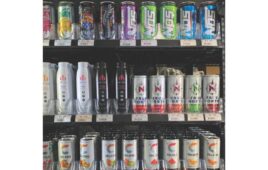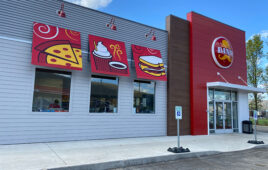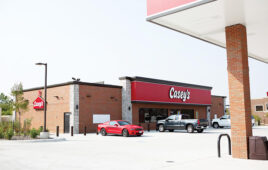As foodservice equipment continues to advance, delivering the ability to prepare food more quickly and with greater taste and quality increasingly spells the difference between robust success and mediocrity.
By Jeffrey Steele, Contributing Editor
Not all foodservice equipment is in back-of-the-house food prep areas. According to Jeff Lenard, vice president of strategic industry initiatives for the National Association of Convenience Stores, open-air coolers that greet customers not far inside convenience store front doors can entice customers to buy.
For c-stores, foodservice provided 22.5% of in-store sales and 33.9% of gross-profit dollars in 2017, according to results from the NACS State of the Industry Report of 2017 Data. Not surprisingly, foodservice equipment is playing a critical role behind those impressive figures.
How do retailers present food that’s fast and appealing? One way is the open-air cooler or fresh case.
“Those refrigerated units don’t have doors, allowing customers to quickly grab a salad, boiled eggs and sandwiches,” said Lenard. “And because there’s no door, it’s a great way to showcase healthier items like assorted fruits and vegetables, yogurt and prepared salads.”
Another piece of in-store equipment being prioritized by c-store operators is the hot case that allows customers to quickly reach for prepared hot food.
When sorting between different foodservice equipment options, owners and operators must give priority to ovens, warmers, microwaves and other gear that consume little space and are versatile enough to allow the store to multitask, Lenard said.
“You have to look at how the equipment can be utilized for different uses,” said Lenard. “You may need that equipment to produce various entrees depending on different daypart or different demographics.”
JOB ONE
The foodservice equipment needs of convenience retailers are as varied as the stores themselves. La Crosse, Wis.-based Kwik Trip offers an extensive grab-and-go menu and sells a variety of sandwiches, appetizers and its very own pizza. Facilities manager Chad Juel said the company considers many factors when purchasing foodservice equipment for its more than 600 retail locations.
Juel looks at items and asks will the equipment make co-workers’ jobs easier and will it improve product offerings. Other factors include maintenance and other considerations.
Among the equipment trends Juel and colleagues are monitoring is the fact remote connectivity is coming to more and more equipment. Being able to evaluate the performance of a piece of equipment, or perform troubleshooting from the company’s support center, is a huge advantage for Kwik Trip.
“We are looking to incorporate equipment diagnostics and reporting into our Building Automation System,” said Juel.
Thanks to advances in equipment technology, another trend is modern ovens’ ability to prepare more food in less time, he said. In some cases, that may mean more than one cook chamber. In other cases, it may involve the use of microwave ovens to reduce cook time.
“Not all store layouts and food volumes are the same,” Juel said. “So each store is evaluated to have the best mix of equipment.”
Kwik Trip, which operates stores in Wisconsin, Minnesota and Iowa, is committed to growing its food program, and recognizes it must invest in its facilities in order to do so.
Each year, the company evaluates all its stores to determine where it can use capital expenditure dollars to increase sales. That evaluation can lead to new equipment in its stores, kitchen additions to provide more space or HVAC store upgrades to handle the heat load generated by foodservice equipment, Juel said.
As for service agreements with suppliers, Juel explained Kwik Trip is always seeking to leverage its vertical integration, which includes the company service department.
“We only purchase foodservice equipment that we can service ourselves,” said Juel. “Because of this, our expectation is that we are able to perform all warranty, preventative, maintenance and corrective maintenance repairs.”
Another important function of foodservice equipment is helping operators maintain food safety.
“If serving [prepared] foods, you have to be attuned to food safety issues,” said NACS’ Lenard. “It’s critical to work with your equipment vendors to make sure that every food item you prepare and serve is done with as much attention to food safety as possible. You can’t just sell food; you have to sell food safety. As convenience stores differentiate themselves from other channels that also serve food, and as they serve more fresh and prepared food, it’s critical to focus on quality not just related to food taste but to food safety. And they need to rely on someone who can help them do that.”
FRESH AND HOMEMADE
Often, how much equipment is needed is entirely dependent on the amount of from-scratch food preparation the store undertakes.
Santa Ana, N.M.-based Warrior Fuel, which has two Sandoval County locations, uses stoves, ovens, refrigerators, freezers, microwaves, burrito warmers, cold cases and open-face refrigerators in preparing the stores’ authentic Mexican specialties, said Sylvia Gibson, manager of retail operations. Featured fare includes homemade soups, burritos, tamales and more. The stores open at 5 a.m., and serve breakfast, lunch and dinner.
All the stores’ south-of-the-border sensations are prepared on the stove in the kitchen, and then carried to the warmers in the store where they’re kept fresh and hot. “Everything is fresh and homemade,” Gibson said. “We serve a lot of different entrees.”
The equipment attributes Gibson and staff prize the most include simplicity, compact size and versatility.
“Everything needs to look clean and be easy to work with and be convenient, [to ensure] volume and customer service,” said Gibson. “Compactness is important, but we have pretty good-sized kitchens. Versatility is essential; it’s very important we can prepare many different food items on a piece of equipment.”




